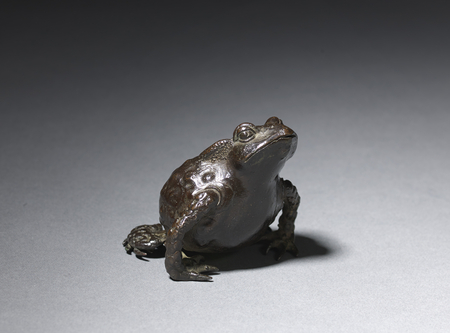Product Description
7207 A bronze suiteki (water dropper) in the form of a gama (toad)
Japan 19th century Edo period
Dimensions: H.2¼” x W. 2¾” (5.5cm x 6.5cm)
In some instances in Japanese legend and art gama (toad) and kaeru (frog) are interchangeable. However, it is the long lived, terrestrial toad that is most closely associated with myth and magic, as is reflected in the expression gama yojutsu (black arts of the toad).
Japanese legend tells of Gama Sennin, also known as Kosensei, a wise old man with a hunched body and a warty face who wanders the land with his toad companion, who teaches him the secret powers of herbs, including the secret of immortality. This tale is similar to a Chinese legend involving a wandering wise man called Liu Hai and his three-legged toad companion Ch’an Chu. The toad knows the secret of eternal life and for his friendship reveals the secret to the wise man.
In many ancient Chinese tales and legends, the toad is a trickster and a magician, a master of escapes and spells. He is also the keeper of the real, powerful secrets of the world, such as the secret of immortality. It is such ascribed powers that undoubtedly led the Chinese, and later the Japanese, to associate the toad with Taoists who seek to develop these talents.







